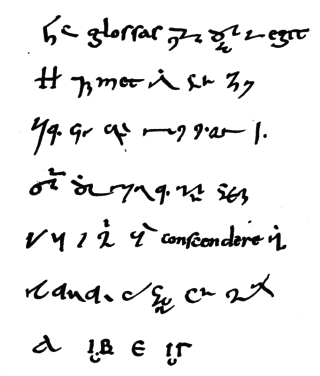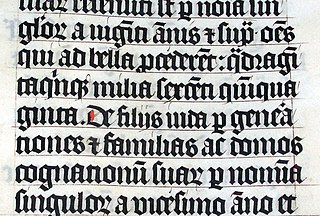An abbreviation is a shortened form of a word or phrase, by any method including shortening, contraction, initialism or crasis.

X, or x, is the twenty-fourth letter of the Latin alphabet, used in the modern English alphabet, the alphabets of other western European languages and others worldwide. Its name in English is ex, plural exes.

The is a grammatical article in English, denoting persons or things that are already or about to be mentioned, under discussion, implied or otherwise presumed familiar to listeners, readers, or speakers. It is the definite article in English. The is the most frequently used word in the English language; studies and analyses of texts have found it to account for seven percent of all printed English-language words. It is derived from gendered articles in Old English which combined in Middle English and now has a single form used with nouns of any gender. The word can be used with both singular and plural nouns, and with a noun that starts with any letter. This is different from many other languages, which have different forms of the definite article for different genders or numbers.

English plurals include the plural forms of English nouns and English determiners. This article discusses the variety of ways in which English plurals are formed from the corresponding singular forms, as well as various issues concerning the usage of singulars and plurals in English. For plurals of pronouns, see English personal pronouns.
A three-letter acronym (TLA), or three-letter abbreviation, is as the phrase suggests an abbreviation consisting of three letters. The abbreviation for TLA, TLA, has a special status among abbreviations and to some is humourous since abbreviations that are three-letters long are very common and TLA is, in fact, a TLA.
Dutton Speedwords, transcribed in Speedwords as Dutton Motez, is an international auxiliary language as well as an abbreviated writing system using the English alphabet for all the languages of the world. It was devised by Reginald J. G. Dutton (1886–1970) who initially ran a shorthand college promoting Dutton Shorthand, then offered a mail order (correspondence) self-education course in Speedwords while still supporting the Dutton Shorthand. The business was continued by his daughter Elizabeth after his death.

Et cetera, abbreviated to etc., et cet., &c. or &c, is a Latin expression that is used in English to mean "and other things", or "and so forth". Translated literally from Latin, et means 'and', while cētera means 'the rest'; thus, the expression translates to 'and the rest '.

Gregg shorthand is a system of shorthand developed by John Robert Gregg in 1888. Distinguished by its phonemic basis, the system prioritizes the sounds of speech over traditional English spelling, enabling rapid writing by employing elliptical figures and lines that bisect them. Gregg shorthand's design facilitates smooth, cursive strokes without the angular outlines characteristic of earlier systems like Duployan shorthand, thereby enhancing writing speed and legibility.

Tironian notes are a form of thousands of signs that were formerly used in a system of shorthand dating from the 1st century BCE and named after Tiro, a personal secretary to Marcus Tullius Cicero, who is often credited as their inventor. Tiro's system consisted of about 4,000 signs, extended to 5,000 signs by others. During the medieval period, Tiro's notation system was taught in European monasteries and expanded to a total of about 13,000 signs. The use of Tironian notes declined after 1100 but lasted into the 17th century. A few Tironian signs are still used today.

An acronym, a type of abbreviation, is a word or name consisting of a phrase whose only pronounced elements are the initial letters or initial sounds of words inside that phrase. Some authorities narrow the definition of acronym as only being pronounced as a single word rather than individual letters, thus considering NASA an acronym but not USA ; the latter they instead call an initialism or alphabetism, for a string of initial letters pronounced individually. Acronyms commonly are formed from initials alone, such as NATO, FBI, GIF, EMT, and PIN, but sometimes use syllables instead, as in Benelux, NAPOCOR, and TRANSCO. They can also be a mixture, as in radar and MIDAS.

Scribal abbreviations or sigla are abbreviations used by ancient and medieval scribes writing in various languages, including Latin, Greek, Old English and Old Norse.

Nota bene is a Latin phrase meaning "note well". It is often abbreviated as NB or n.b., and first appeared in English writing c. 1711. In Modern English, it is used, particularly in legal papers, to draw the attention of the reader to a certain (side) aspect or detail of the subject being addressed. While NB is also often used in academic writing, note is a common substitute.
The term ante Christum natum, usually abbreviated to a. Chr. n., a.Ch.n., a.C.n., A.C.N., or ACN, denotes the years before the birth of Jesus Christ. It is a Latin equivalent to the English "BC". The phrase ante Christum natum is also seen shortened to ante Christum, similarly abbreviated to a. Chr., A. C. or AC. A related phrase, p. Chr. n., p. Ch. n., or post Christum natum complements a. Ch. n. and is equivalent to Anno Domini (AD).

The Phillips Code is a brevity code (shorthand) created in 1879 by Walter P. Phillips for the rapid transmission of press reports by telegraph.
The grave accent is a diacritical mark used to varying degrees in French, Dutch, Portuguese, Italian, Catalan and many other western European languages as well as for a few unusual uses in English. It is also used in other languages using the Latin alphabet, such as Mohawk and Yoruba, and with non-Latin writing systems such as the Greek and Cyrillic alphabets and the Bopomofo or Zhuyin Fuhao semi-syllabary. It has no single meaning, but can indicate pitch, stress, or other features.
In logical argument and mathematical proof, the therefore sign, ∴, is generally used before a logical consequence, such as the conclusion of a syllogism. The symbol consists of three dots placed in an upright triangle and is read therefore. While it is not generally used in formal writing, it is used in mathematics and shorthand.

The articles in English are the definite article the and the indefinite articles a and an. They are the two most common determiners. The definite article is the default determiner when the speaker believes that the listener knows the identity of a common noun's referent. The indefinite article is the default determiner for other singular, countable, common nouns, while no determiner is the default for other common nouns. Other determiners are used to add semantic information such as amount, proximity, or possession.

The system of geometric shorthand published in Britain by Samuel Taylor in 1786, under the title An essay intended to establish a standard for an universal system of Stenography, or Short-hand writing, was the first shorthand system to be used across the English-speaking world. Taylor shorthand uses an alphabet of 19 letters of simplified shape. His book was translated and published in France by Théodore-Pierre Bertin in 1792 under the title Système universel et complet de Stenographie ou Manière abrégée d'écrire applicable à tous les idiomes.
Heterogram is a term used mostly in the study of ancient texts for a special kind of a logogram consisting of the embedded written representation of a word in a foreign language, which does not have a spoken counterpart in the main (matrix) language of the text. In most cases, the matrix and embedded languages share the same script. While from the perspective of the embedded language the word may be written either phonetically or logographically, it is never a phonetic spelling from the point of view of the matrix language of the text, since there is no relationship between the symbols used and the underlying pronunciation of the word in the matrix language.










